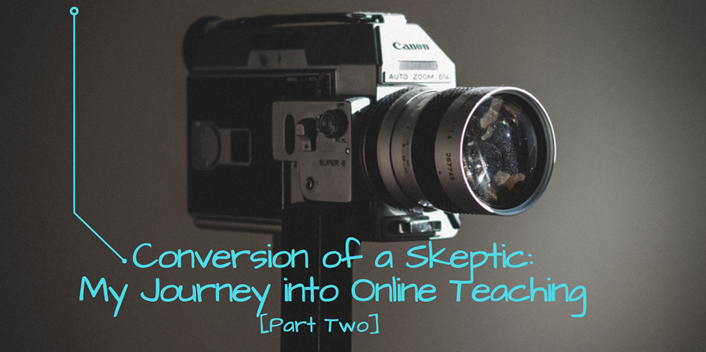
Teaching, of course, is my passion as well as my job, and (as described in my first post) I could hardly consider the task of recording lesson ‘featurettes’ an exercise in tedium. On the contrary, the very idea of creating what amounted to my own TV series was electric — all the more so given that none of my colleagues were even remotely involved in such an endeavor. Furthermore, since I happen to have a modicum of theatrical background and experience, I began to contrive ways of integrating a degree of acting into each production.
It all began with the most popular, indeed the ‘flagship’ course of our program: the History of the Holocaust. As I begin scripting the various episodes, I considered the assorted characters who appear and disappear in this most tragic event in human history. There was, for example, the Lutheran minister who courageously stood up against the Nazi tyranny of his day, only to be imprisoned in a concentration camp. Rather than merely talking about him and the lessons conveyed by his life experience, might I actually impersonate him, donning a clerical collar and feigning a German accent, so as to bring him to life in front of my students in a way that I would be hard-pressed to replicate in the conventional classroom?
Recording the piece was the easy part. My videographer managed the considerable task of converting raw footage, recorded in front of a green screen, into a cinematic mini-documentary, involving scores of graphic images as background and further enhanced with a musical track. Assembling the full ‘featurettte’ required between two and three hours of postproduction editing per minute of final product. While this represented a staggering time commitment for the university videographer who helped me brainstorm this approach, he nonetheless maintained that this was some of the finest work he had undertaken in his career. The only serious challenge we faced was not his desire to complete each production, but an obvious lack of hours in his workday. Moreover, the lack of dedicated staff assigned to this endeavor threatened to sink my project at the outset. Having experienced what might be technologically possible with regard to creating a truly transformational online pedagogical platform, I sadly realized I might be no closer to achieving my goal than when I first lamented my predicament to my instructional designer.
“Flipping” the Online Classroom: When Technology Meets Artistry
By some lucky alignment of stars, fate seemed to intervene at precisely the right moment when staff from the College of Arts and Humanities who had seen snippets of my video work became involved on my behalf. A young graduate student in the university's film school, gifted with a particular flair for video editing, was offered a special stipend to work on my project while he continued his studies. Having seen what our professional videographer was able to produce, I was somewhat uneasy about the quality of the work I might now expect to receive. All qualms vanished, however, when our student editor sent me his first episode. It was artistically crafted on every level, from the moody intro music, through my narrative discourse (including my own impersonations, in costume, of historical characters) and on to the closing credits. This, I felt, was teamwork at its finest. As the semester progressed, the entire course would be fleshed out with online featurettes, maintaining high academic content and integrity, while engaging each and every student with a new kind of "flipped classroom."1
I well understood that in traditional classroom settings, I was lucky to engage meaningfully as many as one third of the students enrolled in my courses, always having to cope with the phenomenon of absent minds and often times absent bodies to match.2 I often found that absenteeism was particularly acute in the second half of each semester, and I sometimes wondered whether my own presence in the classroom, notwithstanding my animated teaching style, even mattered. When exam time rolled around, students expected a detailed study guide, as if to compensate for their lack of engagement in the face-to-face class sessions.
Now, however, I could be assured that all of my students were paying rapt attention to the content of my lectures, since, at the close of each week's material, a strictly timed online quiz was embedded in the web course, testing detailed and specific points brought out in the relevant video episode. Each student obviously had the option of pausing or rewinding the video, while being encouraged to take notes on what was being presented. After all, during the 20-minute weekly quiz, the student either knew the material or did not. While I could no longer look my students in the eye, the mostly-unprompted feedback I was receiving was overwhelmingly positive. Moreover, their test scores were such that I honestly felt on the threshold of reaching the elusive dream of every professor: to achieve 100% engagement from every student. Total understanding of the material is of course a different matter, but at the very least I could be assured that students were seriously absorbing what the teacher was teaching.3 My skepticism of online teaching was waning by the day.
This is the second post in a three-part series. Read The Conversion of a Skeptic: My Journey into Online Teaching (Part I), and stay tuned for Part III!
Notes
- J. L. Bishop and M. A. Verleger, “The Flipped Classroom: A Survey of the Research,” in ASEE National Conference Proceedings, Atlanta, GA 30 (9) (2013).
- National Survey of Student Engagement, A fresh look at student engagement: Annual Results 2013 (Bloomington, IN: Indiana University Center for Postsecondary Research, 2013).
- G. Kearsley and B. Shneiderman, “Engagement Theory: A Framework for Technology-Based Teaching and Learning ,” Educational Technology 38 (5) (1999): 20–23.
Kenneth L. Hanson serves as Director of the University of Central Florida's Interdisciplinary Program in Judaic Studies.
